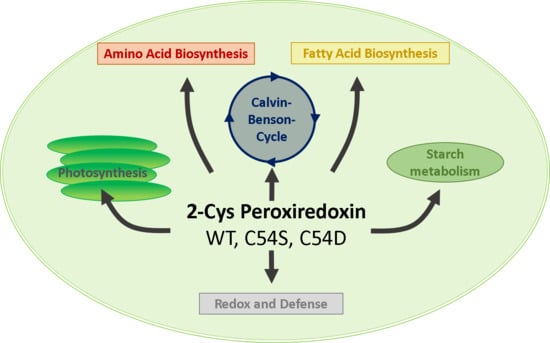Redox Conformation-Specific Protein–Protein Interactions of the 2-Cysteine Peroxiredoxin in Arabidopsis
Abstract
1. Introduction
2. Materials and Methods
2.1. Plant Growth and Extraction of Proteins
2.2. Affinity-Based Interaction Assay
2.3. Peptide Preparation and Mass Spectrometric Analysis
2.4. Cloning and Heterologous Expression of Recombinant Proteins
2.5. Isothermal Titration Microcalorimetry (ITC)
2.6. Far Western Overlay
2.7. LIPOXYGENASE and ß-CARBONIC ANHYDRASE Activity Assays
3. Results
3.1. Identified Chloroplast Polypeptides
3.2. Validation of Potential Targets
4. Discussion
4.1. 2-CysPRX Protein–Protein Interactions: Comparing Current Knowledge and New Results
4.2. Lack of 2-CysPRX in Plants: A Focus on Transcript and Metabolite Level
4.3. Novel Interaction Partners of 2-CysPRX and Redox Regulation
5. Conclusions
Supplementary Materials
Author Contributions
Funding
Acknowledgments
Conflicts of Interest
References
- Scheibe, R.; Dietz, K.J. Reduction–oxidation network for flexible adjustment of cellular metabolism in photoautotrophic cells. Plant Cell Environ. 2012, 35, 202–216. [Google Scholar] [CrossRef]
- Dietz, K.J. Redox signal integration: From stimulus to networks and genes. Physiol. Plant. 2008, 133, 459–468. [Google Scholar] [CrossRef]
- Liebthal, M.; Maynard, D.; Dietz, K.J. Peroxiredoxins and redox signaling in plants. Antioxid. Redox Signal. 2018, 28, 609–624. [Google Scholar] [CrossRef] [PubMed]
- Foyer, C.H.; Noctor, G. Redox homeostasis and antioxidant signaling: A metabolic interface between stress perception and physiological responses. Plant Cell 2005, 17, 1866–1875. [Google Scholar] [CrossRef] [PubMed]
- Rhee, S.G. Overview on peroxiredoxin. Mol. Cells 2016, 39, 1–5. [Google Scholar] [PubMed]
- Kim, K.; Kim, I.H.; Lee, K.Y.; Rhee, S.G.; Stadtman, E.R. The isolation and purification of a specific “protector” protein which inhibits enzyme inactivation by a thiol/Fe (III)/O2 mixed-function oxidation system. J. Biol. Chem. 1988, 263, 4704–4711. [Google Scholar] [PubMed]
- Storz, G.; Jacobson, F.S.; Tartaglia, L.A.; Morgan, R.W.; Silveira, L.A.; Ames, B.N. An alkyl hydroperoxide reductase induced by oxidative stress in Salmonella typhimurium and Escherichia coli: Genetic characterization and cloning of ahp. J. Bacteriol. 1989, 171, 2049–2055. [Google Scholar] [CrossRef] [PubMed]
- Chae, H.Z.; Robison, K.; Poole, L.B.; Church, G.; Storz, G.; Rhee, S.G. Cloning and sequencing of thiol-specific antioxidant from mammalian brain: Alkyl hydroperoxide reductase and thiol-specific antioxidant define a large family of antioxidant enzymes. Proc. Natl. Acad. Sci. USA 1994, 91, 7017–7021. [Google Scholar] [CrossRef]
- Baier, M.; Dietz, K.J. Primary structure and expression of plant homologues of animal and fungal thioredoxin-dependent peroxide reductases and bacterial alkyl hydroperoxide reductases. Plant Mol. Biol. 1996, 31, 553–564. [Google Scholar] [CrossRef]
- Dietz, K.J. Plant peroxiredoxins. Annu. Rev. Plant Biol. 2003, 54, 93–107. [Google Scholar] [CrossRef]
- Peltier, J.B.; Cai, Y.; Sun, Q.; Zabrouskov, V.; Giacomelli, L.; Rudella, A.; Ytterberg, A.J.; Rutschow, H.; van Wijk, K.J. The oligomeric stromal proteome of Arabidopsis thaliana chloroplasts. Mol. Cell. Proteom. 2006, 5, 114–133. [Google Scholar] [CrossRef]
- Vaseghi, M.J.; Chibani, K.; Telman, W.; Liebthal, M.F.; Gerken, M.; Schnitzer, H.; Müller, S.M.; Dietz, K.J. The chloroplast 2-cysteine peroxiredoxin functions as thioredoxin oxidase in redox regulation of chloroplast metabolism. eLife 2018, 7, e38194. [Google Scholar] [CrossRef]
- Telman, W.; Liebthal, M.; Dietz, K.J. Redox regulation by peroxiredoxins is linked to their thioredoxin-dependent oxidase function. Photosynth. Res. 2020. In press. [Google Scholar] [CrossRef] [PubMed]
- König, J.; Galliardt, H.; Jütte, P.; Schäper, S.; Dittmann, L.; Dietz, K.J. The conformational bases for the two functionalities of 2-cysteine peroxiredoxins as peroxidase and chaperone. J. Exp. Bot. 2013, 64, 3483–3497. [Google Scholar] [CrossRef] [PubMed]
- Biteau, B.; Labarre, J.; Toledano, M.B. ATP-dependent reduction of cysteine–sulphinic acid by S. cerevisiae sulphiredoxin. Nature 2003, 425, 980–984. [Google Scholar] [CrossRef]
- Cerveau, D.; Kraut, A.; Stotz, H.U.; Mueller, M.J.; Couté, Y.; Rey, P. Characterization of the Arabidopsis thaliana 2-Cys peroxiredoxin interactome. Plant Sci. 2016, 252, 30–41. [Google Scholar] [CrossRef] [PubMed]
- Muthuramalingam, M.; Seidel, T.; Laxa, M.; De Miranda, S.M.N.; Gärtner, F.; Ströher, E.; Kandlbinder, A.; Dietz, K.J. Multiple redox and non-redox interactions define 2-Cys peroxiredoxin as a regulatory hub in the chloroplast. Mol. Plant 2009, 2, 1273–1288. [Google Scholar] [CrossRef]
- Liebthal, M.; Strüve, M.; Li, X.; Hertle, Y.; Maynard, D.; Hellweg, T.; Viehhauser, A.; Dietz, K.J. Redox-dependent conformational dynamics of decameric 2-cysteine peroxiredoxin and its interaction with cyclophilin 20-3. Plant Cell Physiol. 2016, 57, 1415–1425. [Google Scholar] [CrossRef]
- Wilbur, K.M.; Anderson, N.G. Electrometric and colorimetric determination of carbonic anhydrase. J. Biol. Chem. 1948, 176, 147–154. [Google Scholar]
- Datta, P.K.; Shepard, T.H. Carbonic anhydrase: A spectrophotometric assay. Arch. Biochem. Biophys. 1959, 79, 136–145. [Google Scholar] [CrossRef]
- Worthington, K.; Worthington, V. Worthington Enzyme Manual. Worthington Biochemical Corporation. 2011. Available online: http://www.worthington-biochem.com/ca/assay.html (accessed on 26 April 2020).
- Awad, J.; Stotz, H.U.; Fekete, A.; Krischke, M.; Engert, C.; Havaux, M.; Berger, S.; Mueller, M.J. 2-cysteine peroxiredoxins and thylakoid ascorbate peroxidase create a water-water cycle that is essential to protect the photosynthetic apparatus under high light stress conditions. Plant Physiol. 2015, 167, 1592–1603. [Google Scholar] [CrossRef]
- Müller, S.M.; Wang, S.; Telman, W.; Liebthal, M.; Schnitzer, H.; Viehhauser, A.; Sticht, C.; Deltatorre, C.; Wirtz, M.; Hell, R.; et al. The redox-sensitive module of cyclophilin 20-3, 2-cysteine peroxiredoxin and cysteine synthase integrates sulfur metabolism and oxylipin signaling in the high light acclimation response. Plant J. 2017, 91, 995–1014. [Google Scholar] [CrossRef] [PubMed]
- Motohashi, K.; Kondoh, A.; Stumpp, M.T.; Hisabori, T. Comprehensive survey of proteins targeted by chloroplast thioredoxin. Proc. Natl. Acad. Sci. USA 2001, 98, 11224–11229. [Google Scholar] [CrossRef] [PubMed]
- Collin, V.; Issakidis-Bourguet, E.; Marchand, C.; Hirasawa, M.; Lancelin, J.M.; Knaff, D.B.; Miginiac-Maslow, M. The Arabidopsis plastidial thioredoxins New functions and new insights into specificity. J. Biol. Chem. 2003, 278, 23747–23752. [Google Scholar] [CrossRef] [PubMed]
- Pérez-Ruiz, J.M.; Spínola, M.C.; Kirchsteiger, K.; Moreno, J.; Sahrawy, M.; Cejudo, F.J. Rice NTRC is a high-efficiency redox system for chloroplast protection against oxidative damage. Plant Cell 2006, 18, 2356–2368. [Google Scholar] [CrossRef] [PubMed]
- Broin, M.; Cuiné, S.; Peltier, G.; Rey, P. Involvement of CDSP 32, a drought-induced thioredoxin, in the response to oxidative stress in potato plants. FEBS Lett. 2000, 467, 245–248. [Google Scholar] [CrossRef]
- Caporaletti, D.; D’Alessio, A.C.; Rodriguez-Suarez, R.J.; Senn, A.M.; Duek, P.D.; Wolosiuk, R.A. Non-reductive modulation of chloroplast fructose-1, 6-bisphosphatase by 2-Cys peroxiredoxin. Biochem. Biophys. Res. Commun. 2007, 355, 722–727. [Google Scholar] [CrossRef]
- Balmer, Y.; Koller, A.; del Val, G.; Manieri, W.; Schürmann, P.; Buchanan, B.B. Proteomics gives insight into the regulatory function of chloroplast thioredoxins. Proc. Natl. Acad. Sci. USA 2003, 100, 370–375. [Google Scholar] [CrossRef]
- Rouhier, N.; Villarejo, A.; Srivastava, M.; Gelhaye, E.; Keech, O.; Droux, M.; Finkemeier, I.; Samuelsson, G.; Dietz, K.J.; Jacquot, J.P.; et al. Identification of plant glutaredoxin targets. Antioxid. Redox Signal. 2005, 7, 919–929. [Google Scholar] [CrossRef]
- Schürmann, P.; Buchanan, B.B. The ferredoxin/thioredoxin system of oxygenic photosynthesis. Antioxid. Redox Signal. 2008, 10, 1235–1274. [Google Scholar] [CrossRef]
- Sparla, F.; Costa, A.; Schiavo, F.L.; Pupillo, P.; Trost, P. Redox regulation of a novel plastid-targeted β-amylase of Arabidopsis. Plant Physiol. 2006, 141, 840–850. [Google Scholar] [CrossRef]
- Seung, D.; Thalmann, M.; Sparla, F.; Hachem, M.A.; Lee, S.K.; Issakidis-Bourguet, E.; Svensson, B.; Zeeman, S.C.; Santelia, D. Arabidopsis thaliana AMY3 is a unique redox-regulated chloroplastic α-amylase. J. Biol. Chem. 2013, 288, 33620–33633. [Google Scholar] [CrossRef]
- Skryhan, K.; Gurrieri, L.; Sparla, F.; Trost, P.; Blennow, A. Redox regulation of starch metabolism. Front. Plant Sci. 2018, 9, 1344. [Google Scholar] [CrossRef]
- Moroney, J.V.; Bartlett, S.G.; Samuelsson, G. Carbonic anhydrases in plants and algae. Plat Cell Environ. 2001, 24, 141–153. [Google Scholar] [CrossRef]
- Kikutani, S.; Tanaka, R.; Yamazaki, Y.; Hara, S.; Hisabori, T.; Kroth, P.G.; Matsuda, Y. Redox regulation of carbonic anhydrases via thioredoxin in chloroplast of the marine diatom Phaeodactylum tricornutum. J. Biol. Chem. 2012, 287, 20689–20700. [Google Scholar] [CrossRef]
- Hu, H.; Boisson-Dernier, A.; Israelsson-Nordström, M.; Böhmer, M.; Xue, S.; Ries, A.; Godoski, J.; Kuhn, J.M.; Schroeder, J.I. Carbonic anhydrases are upstream regulators of CO2-controlled stomatal movements in guard cells. Nat. Cell Biol. 2010, 12, 87–93. [Google Scholar] [CrossRef]
- Howard, T.P.; Metodiev, M.; Lloyd, J.C.; Raines, C.A. Thioredoxin-mediated reversible dissociation of a stromal multiprotein complex in response to changes in light availability. Proc. Natl. Acad. Sci. USA 2008, 105, 4056–4061. [Google Scholar] [CrossRef]
- Lopez-Calcagno, P.E.; Howard, T.P.; Raines, C.A. The CP12 protein family: A thioredoxin-mediated metabolic switch? Front. Plant Sci. 2014, 5, 9. [Google Scholar] [CrossRef]
- Thieulin-Pardo, G.; Remy, T.; Lignon, S.; Lebrun, R.; Gontero, B. Phosphoribulokinase from Chlamydomonas reinhardtii: A Benson–Calvin cycle enzyme enslaved to its cysteine residues. Mol. BioSystems 2015, 11, 1134–1145. [Google Scholar] [CrossRef]
- McFarlane, C.R.; Shah, N.R.; Kabasakal, B.V.; Echeverria, B.; Cotton, C.A.; Bubeck, D.; Murray, J.W. Structural basis of light-induced redox regulation in the Calvin–Benson cycle in cyanobacteria. Proc. Natl. Acad. Sci. USA 2019, 116, 20984–20990. [Google Scholar] [CrossRef]
- Marri, L.; Zaffagnini, M.; Collin, V.; Issakidis-Bourguet, E.; Lemaire, S.D.; Pupillo, P.; Sparla, F.; Miginiac-Maslow, M.; Trost, P. Prompt and easy activation by specific thioredoxins of Calvin cycle enzymes of Arabidopsis thaliana associated in the GAPDH/CP12/PRK supramolecular complex. Mol. Plant 2009, 2, 259–269. [Google Scholar] [CrossRef] [PubMed]
- Geigenberger, P.; Kolbe, A.; Tiessen, A. Redox regulation of carbon storage and partitioning in response to light and sugars. J. Exp. Bot. 2005, 56, 1469–1479. [Google Scholar] [CrossRef] [PubMed]
- Maynard, D.; Gröger, H.; Dierks, T.; Dietz, K.J. The function of the oxylipin 12-oxophytodienoic acid in cell signaling, stress acclimation, and development. J. Exp. Bot. 2018, 69, 5341–5354. [Google Scholar] [CrossRef] [PubMed]
- Dominguez-Solis, J.R.; He, Z.; Lima, A.; Ting, J.; Buchanan, B.B.; Luan, S. A cyclophilin links redox and light signals to cysteine biosynthesis and stress responses in chloroplasts. Proc. Natl. Acad. Sci. USA. 2008, 105, 16386–16391. [Google Scholar] [CrossRef]
- Park, S.W.; Li, W.; Viehhauser, A.; He, B.; Kim, S.; Nilsson, A.K.; Anderson, M.X.; Kittle, J.D.; Ambavaram, M.M.R.; Luan, S.; et al. Cyclophilin 20-3 relays a 12-oxo-phytodienoic acid signal during stress responsive regulation of cellular redox homeostasis. Proc. Natl. Acad. Sci. USA 2013, 110, 9559–9564. [Google Scholar] [CrossRef] [PubMed]
- Pollmann, S.; Springer, A.; Rustgi, S.; von Wettstein, D.; Kang, C.; Reinbothe, C.; Reinbothe, S. Substrate channeling in oxylipin biosynthesis through a protein complex in the plastid envelope of Arabidopsis thaliana. J. Exp. Bot. 2019, 70, 1483–1495. [Google Scholar] [CrossRef]
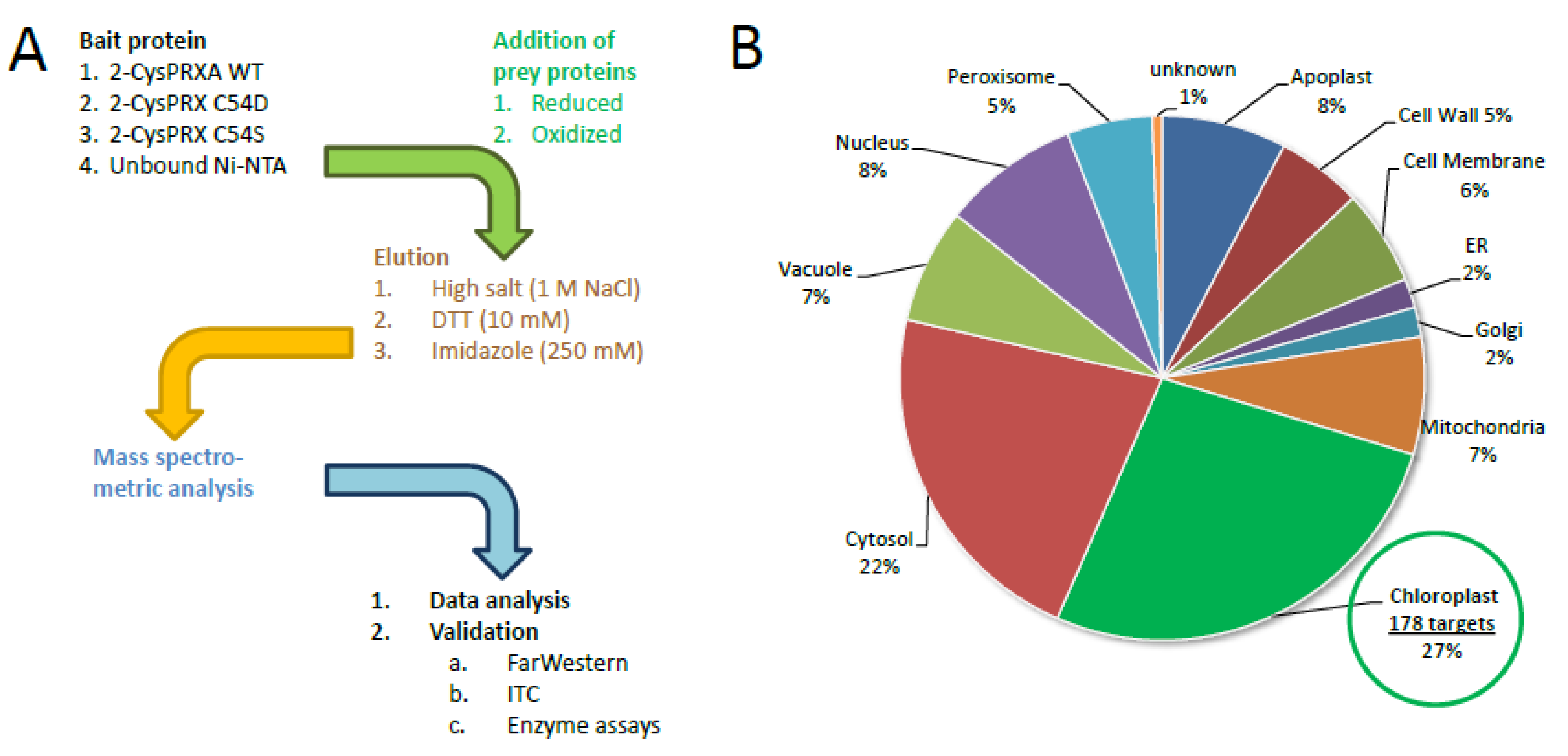
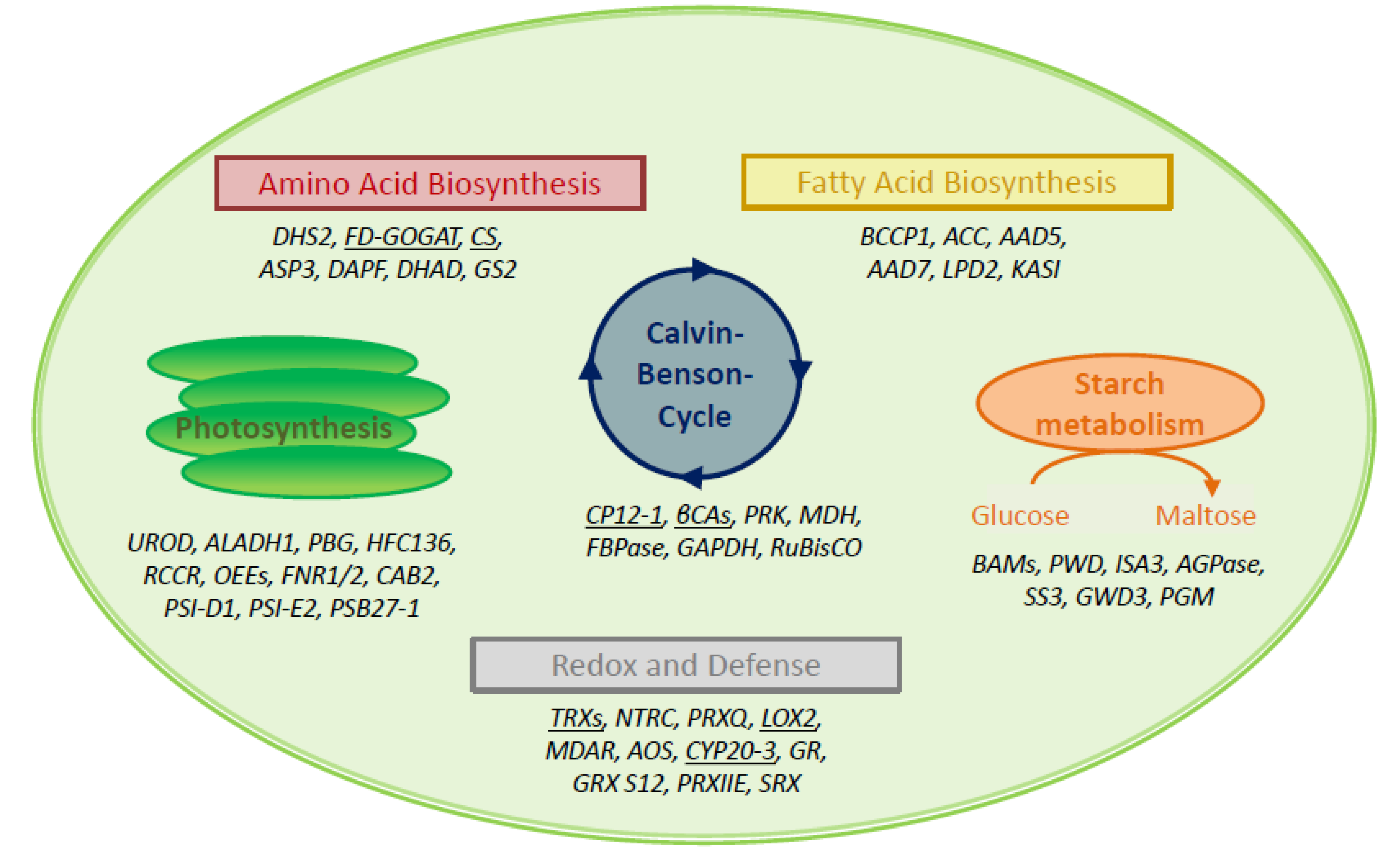
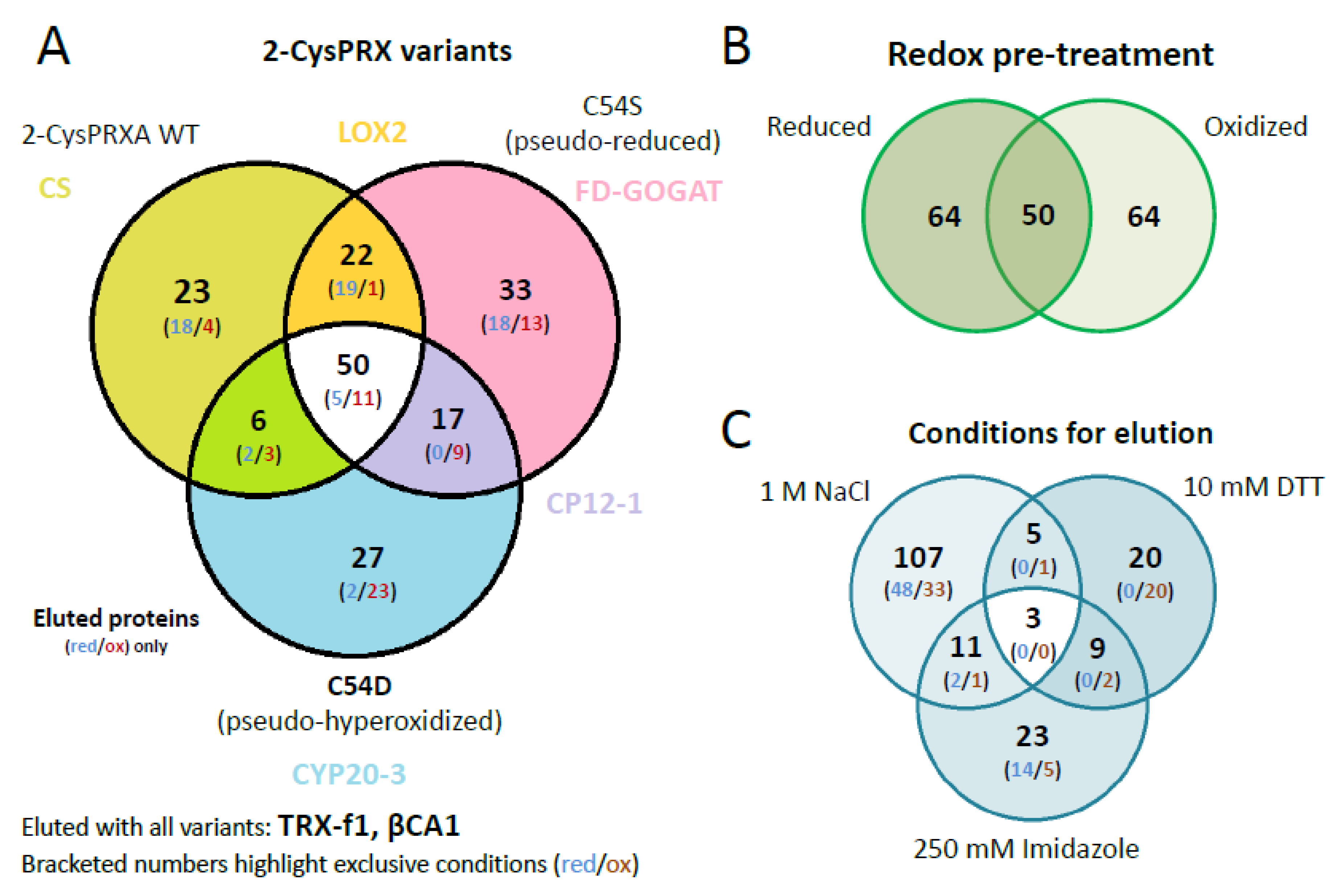
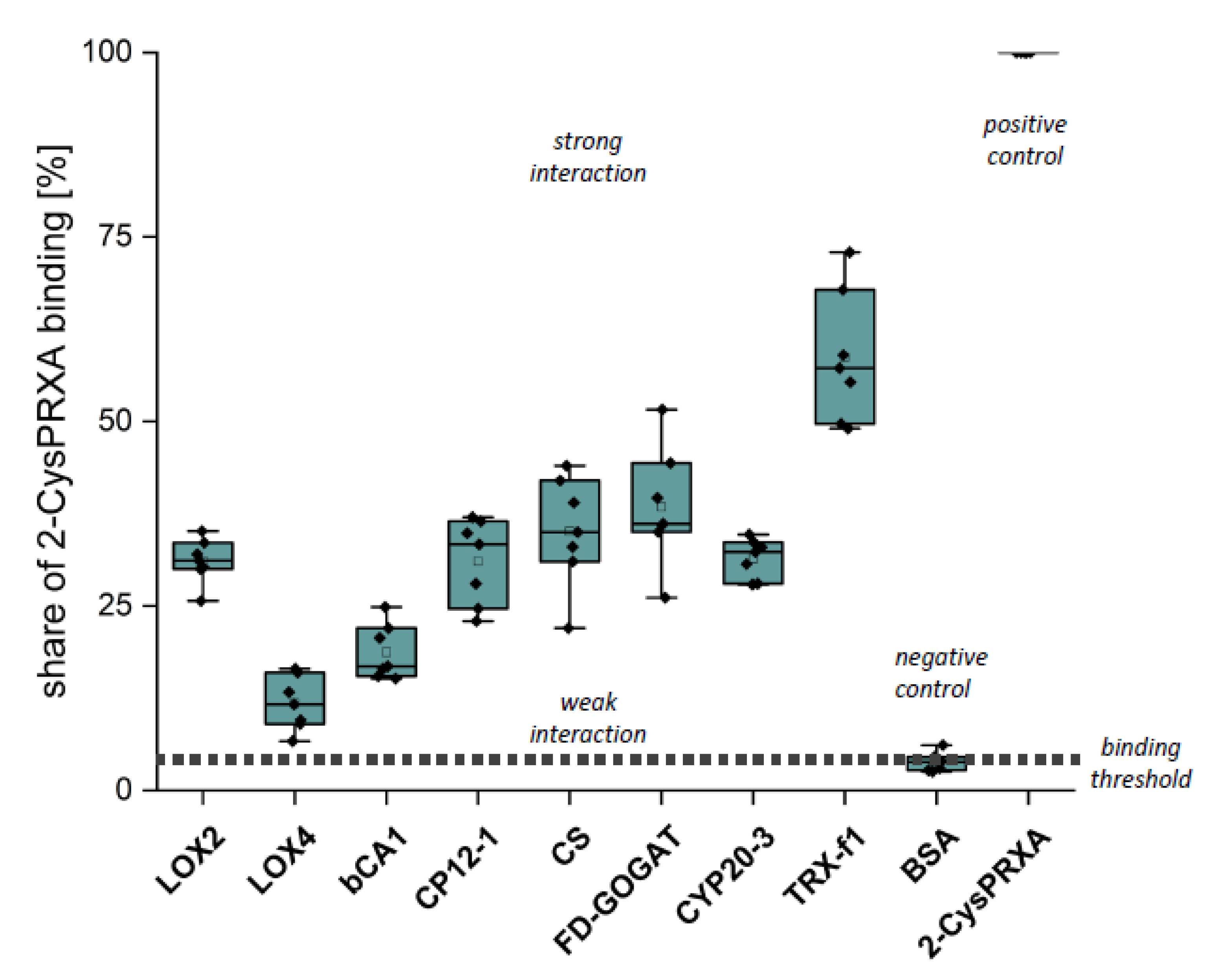
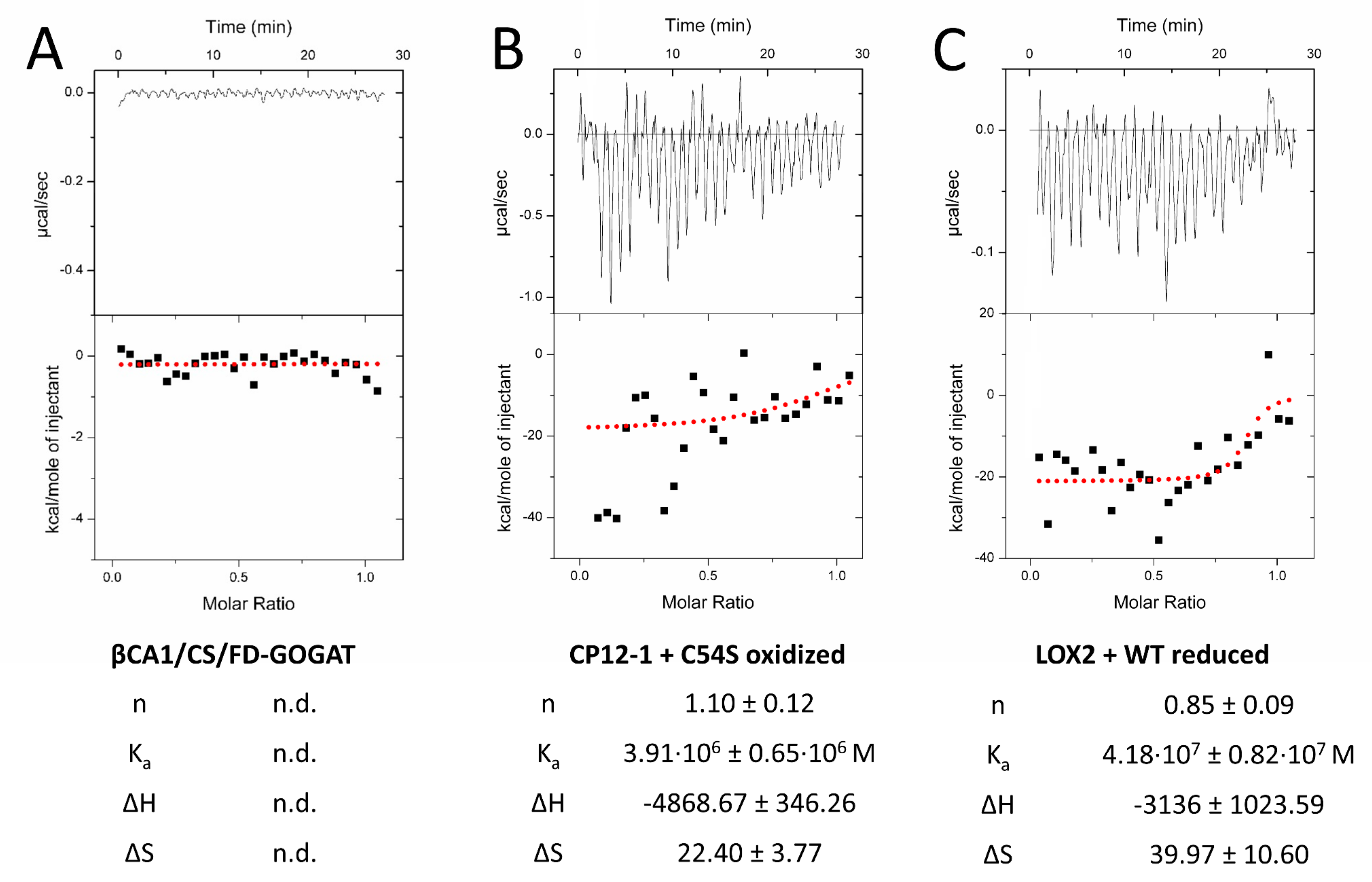
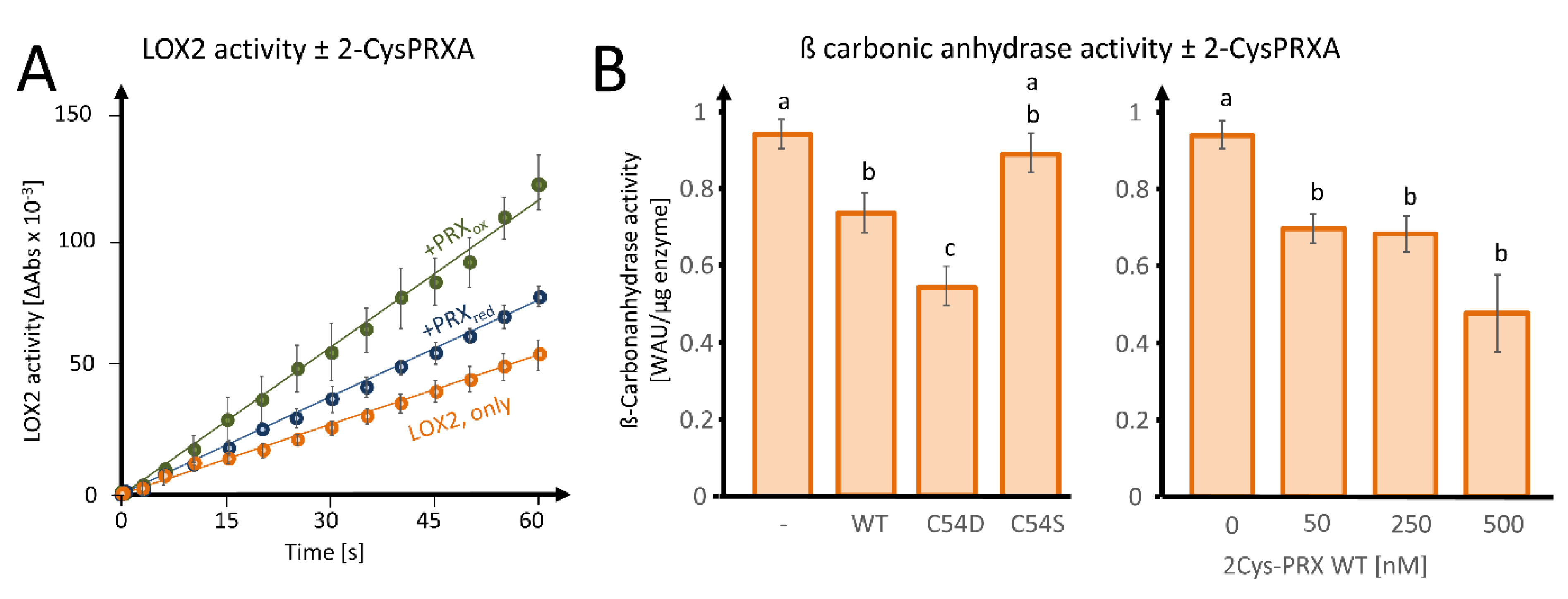
| 2-CysPRXA WT | C54S (Pseudo-Reduced) | C54D (Pseudo-Hyperoxidized) | ||||
|---|---|---|---|---|---|---|
| Reduced | Oxidized | Reduced | Oxidized | Reduced | Oxidized | |
| 1 M NaCl | 30S ribosomal protein S17 (AT1G79850) | HTPA synthase 2 (AT2G45440) | 30S ribosomal protein S6 alpha (AT1G64510) | MECDP synthase (AT1G63970) | Acyl-ACP thioesterase ATL3 (AT1G68260) | HTPA synthase 1 (AT3G60880) |
| DAHP synthase 2 (AT4G33510) | Elongation factor 1 alpha (AT4G20360) | TRAF-like family protein (AT3G28220) | HTPA reductase 1 (AT2G44040) | Adenylosuccinate synthetase (AT3G57610) | ||
| CDPME kinase (AT2G26930) | Ferredoxin--NADP reductase (AT1G20020) | 50S ribosomal protein L27 (AT5G40950) | Allene oxide synthase (AT5G42650) | |||
| 50S ribosomal protein L29 (AT1G79850) | Protein MET1 (AT1G55480) | 50S ribosomal protein L5 (AT4G01310) | AT5g64380/MSJ1_22 (AT5G64380) | |||
| 60S ribosomal protein L26-1 (AT3G49910) | Glutathione S-transferase F8 (AT2G47730) | ATPase alpha subunit (AtCg00120) | Dihydroxy-acid dehydratase (AT3G23940) | |||
| PLAT domain-containing protein 1 (AT4G39730) | Photosystem I reaction center subunit II-1 (AT4G02770) | Monodehydroascorbate reductase 6 (AT1G63940) | E-Z type HEAT repeat- protein (AT3G62530) | |||
| Chlorophyll a-b binding protein 2 (AT1G29920) | Protease Do-like 1 (AT3G27925) | Glutathione reductase (AT3G54660) | ||||
| Chorismate synthase (AT1G48850) | Protein COLD-REGULATED 15A (AT2G42540) | HAD-superfamily hydrolase, 5’-nucleotidase (AT5G48960) | ||||
| Delta-aminolevulinic acid dehydratase 1 (AT1G69740) | Protein COLD-REGULATED 15B (AT2G42530) | Peptidyl-prolyl isomerase CYP20-3 (AT3G62030) | ||||
| Malate dehydrogenase (AT3G47520) | Putative protein (At2G22230) | Photosystem II factor HCF136 (AT5G23120) | ||||
| Phosphoglucan phosphatase LSF1 (AT3G01510) | Soluble pyrophosphatase 6 (AT5G09650) | Plastidial pyruvate kinase 3 (AT1G32440) | ||||
| Probable protein phosphatase 2C 62 (AT4G33500) | Plastocyanin major isoform (AT1G20340) | |||||
| Pyruvate dehydrogenase E1 subunit beta-3 (AT2G34590) | Red chlorophyll catabolite reductase (AT4G37000) | |||||
| Single-stranded DNA-binding protein WHY1 (AT1G14410) | Ribose-P pyrophosphokinase 3 (AT1G10700) | |||||
| Transaldolase-like protein (AT1G12230) | Starch synthase 3 (AT1G11720) | |||||
| Uncharacterized protein (AT2G27680) | Stearoyl-[acyl-carrier-protein] 9-desaturase 5 (AT3G02630) | |||||
| Thiosulfate sulfurtransferase 16 (AT5G66040) | ||||||
| 10 mM DTT | FGGY family of carbohydrate kinase (AT4G30310) | Formate--tetrahydrofolate ligase (AT1G50480) | Phosphofructokinase 5 (AT2G22480) | |||
| NADPH-dep. thioredoxin reductase C (AT2G41680) | NADP-dependent malic enzyme 2 (AT5G11670) | Bifunctional protein FolD 2 (AT3G12290) | ||||
| Oxygen-evolving enhancer protein 1-1 (AT5G66570) | Peroxiredoxin Q (AT3G26060) | |||||
| Plastidial pyruvate kinase 2 (AT5G52920) | ||||||
| Thylakoid lumenal 19 kDa protein (AT3G63540) | ||||||
| 250 mM Imidazole | Sulfiredoxin (AT1G31170) | Arginase 2 (AT4G08870) | 30S ribosomal protein S10 (AT3G13120) | Phosphoglucan, water dikinase (AT5G26570) | ||
| Transketolase-1 (AT3G60750) | BCCP of acetyl-CoA carboxylase 1 (AT5G16390) | Beta-amylase 3 (AT4G17090) | ||||
| Biotin carboxylase (AT5G35360) | Isoamylase 3(AT4G09020) | |||||
| Ferredoxin-dependent glutamate synthase 1 (AT5G04140) | ||||||
| GDSL esterase/lipase ESM1 (AT3G14210) | ||||||
| Myrosinase 2 (AT5G25980) | ||||||
| AIR carboxylase like protein (AT2G37690) | ||||||
| (A) | ||
| 2-CysPRXA Affinity Binding in Arabidopsis | ||
| 17 of 67 (25%) Overlap with [16] | ||
| * | Ribulose bisphosphate carboxylase large subunit | O03042 |
| * | Pyruvate dehydrogenase E1; subunit alpha-3 | O24457 |
| * | Fructose-1,6-bisphosphatase | P25851 |
| * | Glutathione reductase | P42770 |
| * | 3-oxoacyl-[acyl-carrier-protein] synthase 1 | P52410 |
| * | Thylakoid lumenal 19 kDa protein | P82658 |
| * | Phospho-2-dehydro-3-deoxyheptonate aldolase 2 | Q00218 |
| * | Glutathione S-transferase F8 | Q96266 |
| * | 2-Cys peroxiredoxin B | Q9C5R8 |
| * | Photosystem II repair protein PSB27-H1 | Q9LR64 |
| * | Peroxiredoxin Q | Q9LU86 |
| * | Soluble inorganic pyrophosphatase 6 | Q9LXC9 |
| * | 50 S ribosomal protein L1 | Q9LY66 |
| * | Phosphoglucomutase | Q9SCY0 |
| * | Ferredoxin-dependent glutamate synthase 1 | Q9ZNZ7 |
| * | Ferredoxin–NADP reductase 1 | F4JZ46 |
| * | Dihydrolipoyl dehydrogenase 2 | F4JLP5 |
| (B) | ||
| Proteins Associated with FD/TRX system [31] | ||
| * | Fructose 1,6-bisphosphatase | |
| * | Glyceraldehyde 3-P dehydrogenase subunit B | |
| * | Sedoheptulose 1,7-bis-phosphatase | |
| * | Phosphoribulokinase | |
| Rubisco activase | ||
| * | CP12 | |
| * | NADP-malate dehydrogenase | |
| ATP synthase γ-subunit | ||
| Glucose 6-phosphate dehydrogenase | ||
| * | Acetyl CoA carboxylase | |
| * | β-Amylase | |
| * | α-Glucan water dikinase | |
| * | ADP-glucose pyrophosphorylase | |
| * | Peptidyl-prolyl cis-trans isomerase | |
| 2-Cys Peroxiredoxin | ||
| (C) | ||
| TRX-Trapping in Spinach [29] | ||
| 4-hydroxy-3-methylbut-2-en-1-yl diphosphate synthase | Q9FF59 | |
| * | 1-deoxy-D-xylulose-5-phosphate reductoisomerase | Q9SP64 |
| Glutamate-1-semialdehyde aminotransferase | P31593 | |
| * | Uroporphyrinogen decarboxylase | Q42967 |
| Magnesium-chelatase subunit ChlI-1 | P16127 | |
| Phosphomethylpyrimidine synthase | O82392 | |
| * | Thiamine thiazole synthase | Q38814 |
| * | Heat shock 70 protein | O50036 |
| * | RuBisCO large subunit-binding protein subunit alpha | P08926 |
| RuBisCO large subunit-binding protein subunit beta | P08927 | |
| * | ATP-dependent Clp protease | P31541 |
| * | Carbonic anhydrase | P16016 |
| * | Beta-amylase 1 | P16098 |
| Enolase 1 | Q9LEJ0 | |
| ATP-dependent DNA helicase homolog RECG | Q9ZVG0 | |
| LlFtsZ protein | Q9LRC5 | |
| Transketolase | O20250 | |
| Triosephosphate isomerase | P48496 | |
| * | Ribulose-phosphate 3-epimerase | Q43157 |
| D-3-phosphoglycerate dehydrogenase | Q9FSS6 | |
| O-acetylserine (thiol)-lyase B | P32260 | |
| 28 kDa ribonucleoprotein | P28644 | |
| * | Elongation factor Tu | Q43467 |
| Elongation factor G-1 | P34811 | |
| * | 30S ribosomal protein S1 | P29344 |
| * | 30S ribosomal protein S6 alpha | P82403 |
| 6-phosphogluconate dehydrogenase, decarboxylating 2 | Q94KU2 | |
| * | Sedoheptulose-1,7-bisphosphatase | O20252 |
| * | Phosphoribulokinase | P09559 |
| * | Glyceraldehyde-3-phosphate dehydrogenase B | P12860 |
| Ribulose bisphosphate carboxylase/oxygenase activase | P10871 | |
| * | Ribulose bisphosphate carboxylase small chain 2 | Q43832 |
| * | Malate dehydrogenase [NADP] | P52426 |
| * | Glutamate--ammonia ligase | Q9LVI8 |
| * | Biotin carboxylase | O23960 |
| 2Cys-peroxiredoxin | Q9SQJ4 | |
© 2020 by the authors. Licensee MDPI, Basel, Switzerland. This article is an open access article distributed under the terms and conditions of the Creative Commons Attribution (CC BY) license (http://creativecommons.org/licenses/by/4.0/).
Share and Cite
Liebthal, M.; Schuetze, J.; Dreyer, A.; Mock, H.-P.; Dietz, K.-J. Redox Conformation-Specific Protein–Protein Interactions of the 2-Cysteine Peroxiredoxin in Arabidopsis. Antioxidants 2020, 9, 515. https://doi.org/10.3390/antiox9060515
Liebthal M, Schuetze J, Dreyer A, Mock H-P, Dietz K-J. Redox Conformation-Specific Protein–Protein Interactions of the 2-Cysteine Peroxiredoxin in Arabidopsis. Antioxidants. 2020; 9(6):515. https://doi.org/10.3390/antiox9060515
Chicago/Turabian StyleLiebthal, Michael, Johannes Schuetze, Anna Dreyer, Hans-Peter Mock, and Karl-Josef Dietz. 2020. "Redox Conformation-Specific Protein–Protein Interactions of the 2-Cysteine Peroxiredoxin in Arabidopsis" Antioxidants 9, no. 6: 515. https://doi.org/10.3390/antiox9060515
APA StyleLiebthal, M., Schuetze, J., Dreyer, A., Mock, H.-P., & Dietz, K.-J. (2020). Redox Conformation-Specific Protein–Protein Interactions of the 2-Cysteine Peroxiredoxin in Arabidopsis. Antioxidants, 9(6), 515. https://doi.org/10.3390/antiox9060515




